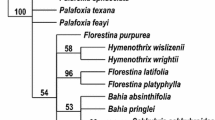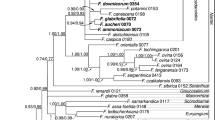Abstract
The tribe Forsythieae comprises 2 genera (Forsythia and Abeliophyllum) and 14 species distributed mostly in the Far East. Although Forsythieae is considered monophyletic, with many symplesiomorphic characters, the phylogenetic status of Abeliophyllum remains controversial. We assessed the phylogenetic relationships of Forsythieae, based on a 3.3-kb plastid fragment (trnL-F region and matK gene) and nuclear internal transcribed spacer (ITS) region DNA sequences. We obtained a highly resolved and strongly supported topology with possible outgroups. The topology of the combined tree was congruent with those of the ITS region and matK gene. Maximum parsimony, maximum likelihood, and Bayesian inference tree analyses for the combined data also yielded identical relationships. Combined sequence data strongly supported the monophyly of Forsythieae and the close relationship between Fontanesia and Jasminum. Oleaceae, not Fontanesia, was found to be a sister group to Forsythieae. Moreover, the genus Abeliophyllum was distinctly independent of Forsythia. Three Forsythia lineages were suggested: (a) ONJ (ovata-nakaii-japonica clade), (b) VGE (viridissima-giraldiana-europaea), and (c) KISS (koreana-intermedia-saxatilis-suspensa). Our results indicated that F. × intermedia is not a hybrid between F. suspensa and F. viridissima, but further studies are needed to determine its taxonomic identity. Furthermore, the diverse fruit shapes in Oleaceae are assumed to be the result of parallelism or convergence.



Similar content being viewed by others
References
Ahn SK, Chung YJ, Lee ST (1995) Palynotaxonomic studies of Abeliophyllum distichum Nakai and its relative taxa (Oleaceae). Sung Kyun Kwan Univ J Nat Sci 46:27–38
Anderson E (1934) Hardy Forsythias. Arnoldia 2:9–14
Bailey LH, Bailey EZ (1976) Hortus, 3rd edn. Macmillan Publishing Co, New York, pp 1090–1091
Bakker FT, Culham A, Daugherty LC, Gibby M (1999) A trnL-F based phylogeny for species of Pelargonium (Geraniaceae) with small chromosomes. Plant Syst Evol 216:309–324
Bakker FT, Culham A, Gomez-Martinez R, Carvalho J, Compton J, Dawtrey R, Gibby M (2000) Patterns of nucleotide substitution in angiosperm cpDNA trnL (UAA)-trnF (GAA) regions. Mol Biol Evol 17:1146–1155
Barker FK, Lutzoni FM (2002) The utility of the incongruence length difference test. Syst Biol 51:625–637
Besnard G, de Casas RR, Christin P-A, Vargas P (2009) Phylogenetics of Olea (Oleaceae) based on plastid and nuclear ribosomal DNA sequences: tertiary climatic shifts and lineage differentiation times. Ann Bot 104:143–160
Chase MW, Solitis DS, Soltis PS, Rudall PJ, Fay MF, Hahn WH, Sullivan S, Joseph J, Givnish T, Sytsma KJ, Pires JC (2000) Higher-level systematics of the monocotyledons: an assessment of current knowledge and a new classification. In: Wilson KL, Morrison DA (eds) Monocots: systematics and evolution. CSIRO, Melbourne, pp 3–16
Chase MW, Fay MF, Devey DS, Maurin O, Rønsted N, Davies TJ, Pillon Y, Petersen G, Seberg O, Tamura MN, Asmussen CB, Hilu K, Borsch T, Davis JI, Stevenson DW, Pires JC, Givnish TJ, Sytsma KJ, McPherson MA, Graham SW, Rai HS (2006) Multigene analyses of monocot relationships: a summary. In: Columbus JT, Friar EA, Porter JM, Prince LM, Simpson MG (eds) Monocots: comparative biology and evolution. Rancho Santa Ana Botanic Garden, California, pp 63–75
Clarkson JJ, Knapp S, Garcia VF, Olmstead RG, Leitch AR, Chase MW (2004) Phylogenetic relationships in Nicotiana (Solanaceae) inferred from multiple plastid DNA regions. Mol Phylogenet Evol 33:75–90
Cunningham CW (1997) Is congruence between data partitions a reliable predictor of phylogenetic accuracy? Empirically testing an iterative procedure for choosing among phylogenetic methods. Syst Biol 46:464–478
Doyle JJ, Doyle JL (1987) A rapid DNA isolation procedure for small quantities of fresh leaf tissue. Phytochem Bull 19:11–15
Farris JS, Kallersjo SM, Kluge AG, Bult C (1995) Testing significance of incongruence. Cladistics 10:315–319
Felsenstein J (1985) Confidence limits on phylogenies: an approach using the bootstrap. Evolution 39:783–791
Fitch WM (1971) Toward defining the course of evolution: minimum change for a specific tree topology. Syst Zool 20:406–416
Gravendeel B, Chase MW, de Vogen EF, Roos MC, Mes THM, Bachmann K (2001) Molecular phylogeny of Coelogyne (Epidendroideae, Orchidaceae) based on plastid RLFPs, matK and nuclear ribosomal ITS sequences: evidence for polyphyly. Am J Bot 88:1915–1927
Harborne JB, Green PS (1980) A chemotaxonomic survey of flavonoids in leaves of the Oleaceae. Bot J Linn Soc 81:155–167
Iwatsuki K, Yamazaki T, Boufford DE, Ohba H (1993) Flora of Japan: Vol. IIIa Angiospermae. Dicotyledoneae, Sympetalae (a). Kodansha, Tokyo, pp 122–135
Jang CG, Pfosser M (2002) Phylogenetics of Ruscaceae sensu lato based on plastid rbcL and trnL-F DNA sequences. Stapfia 80:333–348
Jeandroz S, Roy A, Bousquet J (1997) Phylogeny and phylogeography of the circumpolar genus Fraxinus (Oleaceae) based on internal transcribed spacer sequences of nuclear ribosomal DNA. Mol Phylogenet Evol 7:241–251
Jensen SR, Franzyk H, Wallander E (2002) Chemotaxonomy of the Oleaceae: iridoids as taxonomic markers. Phytochemistry 60:213–231
Johnson LAS (1957) A review of the family Oleaceae. Contributions from the New South Wales National Herbarium 2:395–418
Kim KJ (1999) Molecular phylogeny of Forsythia (Oleaceae) based on chloroplast DNA variation. Plant Syst Evol 218:113–123
Kim DK, Kim JH (2004) Numerical taxonomy of tribe Forsythieae (Oleaceae) in Korea. Korean J Plant Taxon 34:189–203
Kim KJ, Lee HL, Kim YD (2000) Phylogenetic position of Abeliophyllum based on nuclear ITS sequence data. Korean J Plant Taxon 30:235–250
Knapp P (2002) Tobacco to tomatoes: a phylogenetic perspective on fruit diversity in the Solanaceae. J Exp Bot 53:2001–2022
Lee ST (1984) A systematic study of Korean Forsythia species. Korean J Plant Taxon 14:87–107
Lee WT (1996) Lineamenta Florae Koreae. Academy Press, Seoul, p 1699
Lee ST, Park EJ (1982a) A cladistic analysis of the Korean Oleaceae. Korean J Bot 25:57–64
Lee ST, Park EJ (1982b) A palynotaxonomic study of the Korean Oleaceae. Korean J Plant Taxon 12:1–11
Lee HL, Jansen RK, Chumley TW, Kim KJ (2007) Gene relocations within chloroplast genomes of Jasminum and Menodora (Oleaceae) are due to multiple, overlapping inversions. Mol Biol Evol 24:1161–1180
Li J, Alexander JH, Zhang D (2002) Paraphyletic Syringa (Oleaceae): evidence from sequences of nuclear ribosomal DNA ITS and ETS regions. Syst Bot 27:592–597
Lim SC, Ko SC (1989) A cytotaxonomical study on some species of Korean Forsythia. Korean J Plant Taxon 19:229–239
Mabberley DJ (1987) The plant book. Cambridge University Press, Cambridge
Maddison WP, Maddison DR (2000) MacClade: analysis of phylogeny and character evolution, ver. 4.0. Sinauer Associates Inc., Sunderland
Maekawa F (1962) Major polyploidy with special reference to the phylogeny of Oleaceae. J Jap Bot 37:25–27
Melchior H (1964) A. Engler’s Syllabus der Pflanzenfamilien. II. Borntraeger, Berlin, pp 403–405
Nakai T (1919) Genus novum Oleacearum in Corea media inventum. Bot Mag Tokyo 33:153–154
Nylander JAA, Ronquist F, Huelsenbeck JP, Aldrey JLN (2004) Bayesian phylogenetic analysis of combined data. Syst Biol 53:47–67
O’Mara J (1930) Chromosome numbers in the genus Forsythia. J Arnold Arb 11:14–15
Piechura JE, Fairbrothers DE (1983) The use of protein-serological characters in the systematics of the family Oleaceae. Am J Bot 75:780–789
Rehder A (1940) Manual of cultivated trees and shrubs hardy in North America. Macmillan Publishing Co., New York, pp 765–793
Rohwer JG (1996) Die Frucht und Samenstrukturen der Oleaceae. Bibliotheca Botanica 148:1–177
Ronquist F, Huelsenbeck JP (2003) MRBAYES 3: Bayesian phylogenetic inference under mixed models. Bioinformatics 19:1572–1574
Sax K, Abbe EC (1932) Chromosome numbers and the anatomy of the secondary xylem in the Oleaceae. J Arnold Arb 13:37–47
Smith JF (2000) A phylogenetic analysis of tribes Beslerieae and Napeantheae (Gesneriaceae) and evolution of fruit types: parsimony and maximum likelihood analyses of ndhF sequences. Syst Bot 25:72–81
Swofford DL (2002) PAUP*: phylogenetic analysis using parsimony (and other methods). 4.0 Beta. Sinauer Associates, Sunderland, MA
Tae KH, Kim DK, Kim JH (2005) Genetic variations and phylogenetic relationships of tribe Forsythieae (Oleaceae) based on RAPD analysis. Korean J Plant Res 8:135–144
Taylor H (1945) Cyto-taxonomy and phylogeny of the Oleaceae. Brittonia 5:337–369
Thompson JD, Gibson TJ, Plewniak F, Jeanmougin F, Higgins DG (1997) The Clustal X windows interface: flexible strategies for multiple sequence alignment aided by quality analysis tools. Nucleic Acids Res 24:4876–4882
Wallander E (2008) Systematics of Fraxinus (Oleaceae) and evolution of dioecy. Plant Syst Evol 273:25–49
Wallander E, Albert VA (2000) Phylogeny and classification of Oleaceae based on rps16 and trnL-F sequence data. Am J Bot 87:1827–1841
Willis JC (1973) A dictionary of the flowering plants and ferns, 8th edn. Cambridge University Press, Cambridge
Wu ZY, Raven PH (1996) Flora of China. Myrsinaceae through Loganiaceae, vol 15. Missouri Botanic Garden Press, St. Louis, pp 272–319
Yamashita J, Tamura MN (2000) Molecular phylogeny of the Convallariaceae (Asparagales). In: Wilson KL, Morrison DA (eds) Monocots: systematics and evolution. CSIRO, Melbourne, pp 387–400
Yoon HS, Hackett JD, Pinto G, Bhattacharya D (2002) The single, ancient origin of chromist plastids. PNAS 26:15507–15512
Yue JP, Sun H, David AB, Li JH, Ihsan AAS, Richard REE (2009) Molecular phylogeny of Solms-laubachia (Brassicaceae) s.l., based on multiple nuclear and plastid DNA sequences, and its biogeographic implications. JSE 47:402–415
Zjhra ML, Sytsma KJ, Olmstead RG (2004) Delimitation of Malagasy tribe Coleeae and implications for fruit evolution in Bignoniaceae inferred from a chloroplast DNA phylogeny. Plant Syst Evol 245:55–67
Acknowledgments
This research was supported by the Kyungwon University Research Fund in 2010.
Author information
Authors and Affiliations
Corresponding author
Electronic supplementary material
Below is the link to the electronic supplementary material.
Rights and permissions
About this article
Cite this article
Kim, DK., Kim, JH. Molecular phylogeny of tribe Forsythieae (Oleaceae) based on nuclear ribosomal DNA internal transcribed spacers and plastid DNA trnL-F and matK gene sequences. J Plant Res 124, 339–347 (2011). https://doi.org/10.1007/s10265-010-0383-9
Received:
Accepted:
Published:
Issue Date:
DOI: https://doi.org/10.1007/s10265-010-0383-9




